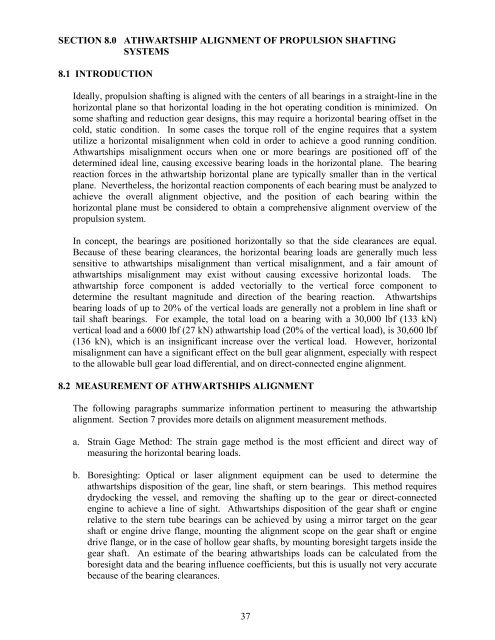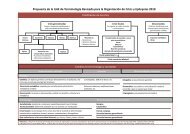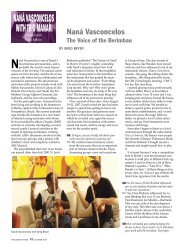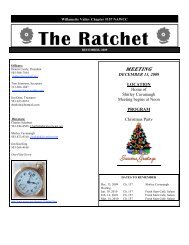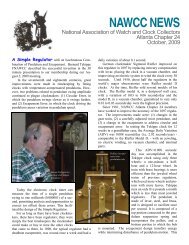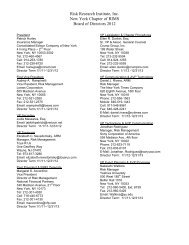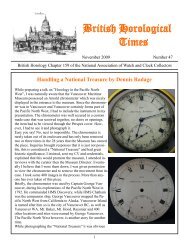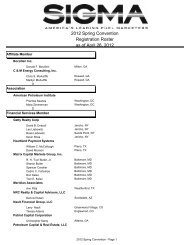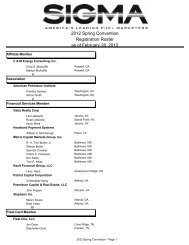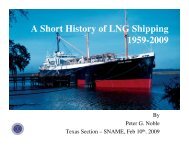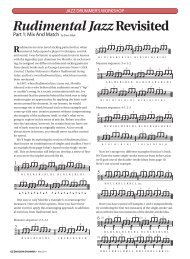Technical and Research Bulletin 3-51 - Amazon Web Services
Technical and Research Bulletin 3-51 - Amazon Web Services
Technical and Research Bulletin 3-51 - Amazon Web Services
You also want an ePaper? Increase the reach of your titles
YUMPU automatically turns print PDFs into web optimized ePapers that Google loves.
SECTION 8.0 ATHWARTSHIP ALIGNMENT OF PROPULSION SHAFTING<br />
SYSTEMS<br />
8.1 INTRODUCTION<br />
Ideally, propulsion shafting is aligned with the centers of all bearings in a straight-line in the<br />
horizontal plane so that horizontal loading in the hot operating condition is minimized. On<br />
some shafting <strong>and</strong> reduction gear designs, this may require a horizontal bearing offset in the<br />
cold, static condition. In some cases the torque roll of the engine requires that a system<br />
utilize a horizontal misalignment when cold in order to achieve a good running condition.<br />
Athwartships misalignment occurs when one or more bearings are positioned off of the<br />
determined ideal line, causing excessive bearing loads in the horizontal plane. The bearing<br />
reaction forces in the athwartship horizontal plane are typically smaller than in the vertical<br />
plane. Nevertheless, the horizontal reaction components of each bearing must be analyzed to<br />
achieve the overall alignment objective, <strong>and</strong> the position of each bearing within the<br />
horizontal plane must be considered to obtain a comprehensive alignment overview of the<br />
propulsion system.<br />
In concept, the bearings are positioned horizontally so that the side clearances are equal.<br />
Because of these bearing clearances, the horizontal bearing loads are generally much less<br />
sensitive to athwartships misalignment than vertical misalignment, <strong>and</strong> a fair amount of<br />
athwartships misalignment may exist without causing excessive horizontal loads. The<br />
athwartship force component is added vectorially to the vertical force component to<br />
determine the resultant magnitude <strong>and</strong> direction of the bearing reaction. Athwartships<br />
bearing loads of up to 20% of the vertical loads are generally not a problem in line shaft or<br />
tail shaft bearings. For example, the total load on a bearing with a 30,000 lbf (133 kN)<br />
vertical load <strong>and</strong> a 6000 lbf (27 kN) athwartship load (20% of the vertical load), is 30,600 lbf<br />
(136 kN), which is an insignificant increase over the vertical load. However, horizontal<br />
misalignment can have a significant effect on the bull gear alignment, especially with respect<br />
to the allowable bull gear load differential, <strong>and</strong> on direct-connected engine alignment.<br />
8.2 MEASUREMENT OF ATHWARTSHIPS ALIGNMENT<br />
The following paragraphs summarize information pertinent to measuring the athwartship<br />
alignment. Section 7 provides more details on alignment measurement methods.<br />
a. Strain Gage Method: The strain gage method is the most efficient <strong>and</strong> direct way of<br />
measuring the horizontal bearing loads.<br />
b. Boresighting: Optical or laser alignment equipment can be used to determine the<br />
athwartships disposition of the gear, line shaft, or stern bearings. This method requires<br />
drydocking the vessel, <strong>and</strong> removing the shafting up to the gear or direct-connected<br />
engine to achieve a line of sight. Athwartships disposition of the gear shaft or engine<br />
relative to the stern tube bearings can be achieved by using a mirror target on the gear<br />
shaft or engine drive flange, mounting the alignment scope on the gear shaft or engine<br />
drive flange, or in the case of hollow gear shafts, by mounting boresight targets inside the<br />
gear shaft. An estimate of the bearing athwartships loads can be calculated from the<br />
boresight data <strong>and</strong> the bearing influence coefficients, but this is usually not very accurate<br />
because of the bearing clearances.<br />
37


